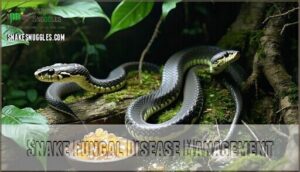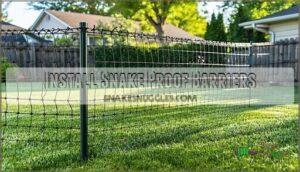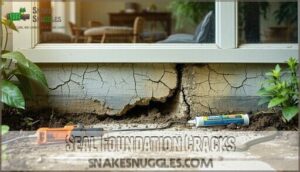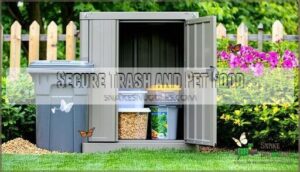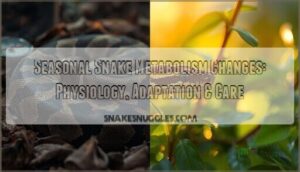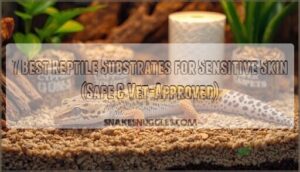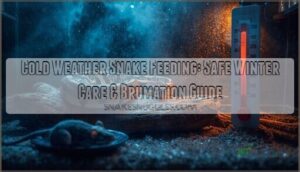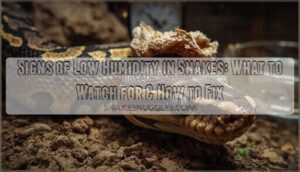This site is supported by our readers. We may earn a commission, at no cost to you, if you purchase through links.
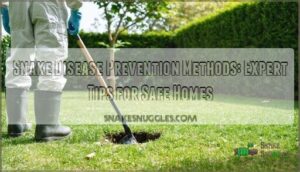
Keep your property clean by removing debris, trimming vegetation, and eliminating water sources that attract both snakes and their prey.
Seal foundation cracks and gaps in structures where snakes might hide or nest.
Control rodent populations since they’re primary food sources for snakes.
For snake fungal disease specifically, maintain proper humidity levels and guarantee good air circulation in areas where snakes might be present.
Wear protective clothing when working outdoors, especially boots and gloves.
Regular inspection and maintenance of your property creates an environment that’s less hospitable to snakes.
These snake disease prevention methods work best when applied consistently and combined with proper identification techniques that can save you from costly mistakes, ensuring a more effective prevention strategy.
Table Of Contents
- Key Takeaways
- Snake Disease Prevention
- Snake Fungal Disease Management
- Preventing Snake Bites
- Snake Proofing Homes
- Yard Maintenance Techniques
- Frequently Asked Questions (FAQs)
- How to prevent disease in snakes?
- What is the most effective way to prevent snake bites?
- What is the best protection for snakes?
- How to prevent snake fungal disease?
- How do snakes transmit diseases to humans?
- Can snakes spread diseases through their bites?
- What vaccines exist for snake-related diseases?
- How long do snake diseases remain contagious?
- Are there seasonal patterns in snake diseases?
- Conclusion
Key Takeaways
- Eliminate snake attractions – You will reduce snake populations by removing food sources like rodents, securing pet food in sealed containers, and eliminating standing water sources that attract both snakes and their prey.
- Modify your landscape strategically – You should clear debris piles, trim dense vegetation, remove basking areas like rocks and concrete slabs, and replace bark mulch with lava rock to create hostile ground surfaces.
- Seal all entry points – You need to close every opening ⅛ inch and larger using mortar for permanent gaps, hardware cloth for ventilation areas, and sheet metal for larger openings to prevent snake access to your home.
- Maintain proper sanitation – You will prevent snake fungal disease by controlling humidity levels, ensuring good air circulation, wearing protective clothing outdoors, and regularly inspecting your property for contamination sources.
Snake Disease Prevention
You can prevent snake-related diseases by removing their food sources, modifying your landscape, and sealing entry points around your home.
Smart prevention starts with eliminating what attracts snakes to your property in the first place.
These proven methods reduce snake populations while protecting your family from potential health risks associated with snake encounters, which is crucial for protecting your family.
Reduce Food Sources
Eliminating rodents cuts off snakes’ primary food supply, making your property less attractive.
Secure pet food in sealed containers and remove birdseed from feeders.
Manage insects through proper waste disposal and eliminate standing water sources.
Control rodent populations by sealing food storage areas and removing debris piles where they nest and breed, which also helps in managing the overall ecosystem.
Modify Landscapes
Strategic landscape modification creates unwelcoming environments that naturally discourage snake habitation.
By removing key habitat features, you’ll establish effective snake barriers without chemicals or complex installations.
- Basking Area Removal – Eliminate rocks, concrete slabs, and metal surfaces where snakes regulate body temperature
- Water Source Reduction – Remove birdbaths, garden ponds, and fix drainage issues that attract prey
- Burrowing Area Removal – Clear woodpiles, stone stacks, and debris piles from property perimeters
- Foliage Management – Trim dense vegetation and remove low-hanging branches near structures
- Habitat Modification – Replace bark mulch with lava rock to create hostile ground surfaces.
Consider lava rock applications for effective snake deterrence.
Seal Openings
You’ll need to seal every opening ⅛ inch and larger to prevent snake entry points effectively.
Use mortar application for permanent gaps, hardware cloth for ventilation areas, and sheet metal for larger openings.
Focus on weep vent security by installing Xcluder cloth or screens.
These snake exclusion methods guarantee thorough sealing effectiveness when implementing snake prevention strategies.
Control Rodent Populations
Rodent control directly impacts snake attraction factors since these pests serve as primary snake food sources. Secure all food storage in metal containers, eliminating accessible meals that draw rodents.
Implement trapping methods using snap traps and bait stations rather than rodenticide risks that create secondary poisoning hazards. Focus on habitat reduction by removing nesting materials and entry points.
Encourage natural predators like owls through proper perch installation for effective snake population control. Snakes also provide natural pest control, targeting insects and slugs.
Snake Fungal Disease Management
When snakes contract fungal disease, you’ll need to act quickly with proper treatment protocols.
Managing infected snakes requires combining antifungal medications with supportive care to give them the best chance of recovery.
They must be treated with the right medications and care to survive.
Antifungal Treatments
When dealing with snake fungal disease, antifungal treatments offer your best defense against this persistent threat.
When fungal disease strikes snakes, swift antifungal action becomes their lifeline to survival.
Treatment efficacy depends on catching infections early and selecting appropriate medication types for your specific situation.
Here are five key antifungal treatment approaches:
- Topical terbinafine cream – Applied daily for 14-28 days, reducing lesion size in 80% of cases
- Systemic itraconazole – Oral medication at 5-10 mg/kg daily for moderate to severe infections
- Combination therapy – Pairing topical and systemic treatments improves recovery rates by 20%
- Environmental decontamination – Using 10% bleach solution reduces fungal spore load by 95%
- Dosage strategies – Careful monitoring prevents hepatotoxicity in 10% of cases receiving prolonged treatment
Resistance development affects 5% of fungal isolates, making future research into alternative antifungals like voriconazole increasingly important for effective reptile disease treatment.
Supportive Care
When treating snake fungal disease, you’ll need thorough supportive care beyond antifungal medications.
Thermal support maintains your snake’s immune function within their preferred temperature range. Fluid balance prevents dehydration through subcutaneous administration when needed.
Meeting dietary needs involves assisted feeding during illness-induced anorexia. Stress reduction through minimal handling and environmental control accelerates recovery.
Environmental factors can also trigger outbreaks. Regular monitoring habits track healing progress effectively, ensuring the snake receives proper care and promoting a healthy environment.
Isolation of Infected Snakes
When you isolate sick animals, you’re creating a firewall against disease spread.
Proper quarantine protocols guarantee containment effectiveness by separating sick snakes from healthy populations.
Isolation duration depends on recovery progress and veterinary guidance.
- Dedicated quarantine space – Set up a separate enclosure away from other animals
- Strict hygiene protocols – Disinfect hands and tools between snake handling sessions
- Limited access controls – Restrict who can enter the quarantine area
- Monitoring schedules – Check isolated snakes daily for symptom changes
Snake quarantine procedures require reducing transmission through physical separation and controlled environments.
Preventative measures include maintaining proper temperatures and humidity levels during isolation.
Post-isolation care involves gradual reintegration once veterinary clearance confirms recovery.
Regular Environmental Control
When maintaining environmental control for infected snakes, focus on habitat hygiene through regular soil sterilization and thermal support systems.
Monitor nutrition carefully while ensuring proper fluid balance to reduce stress.
Consistent environmental care includes habitat modification that eliminates contamination sources.
These reptile hygiene practices create ideal recovery conditions by maintaining stable temperatures and humidity levels essential for healing.
Preventing Snake Bites
You’ll face snake bite risks when working in yards, gardens, or outdoor areas where snakes naturally occur.
Proper protective measures and awareness can substantially reduce your chances of dangerous encounters with both venomous and non-venomous species.
Wear Protective Clothing
Proper protective clothing serves as your first line of defense against snake bites during outdoor activities.
Fang-proof boots and long trousers substantially reduce snakebite incidents among workers and rural populations, providing essential leg protection and footwear protection.
Consider these protective gear essentials:
- Heavy-duty boots – Choose leather or rubber boots that extend above the ankle for maximum foot and lower leg coverage
- Thick pants – Wear denim or canvas material that offers durability and material durability against snake fangs
- Gloves – Use leather work gloves for hand protection when handling debris or working in snake-prone areas
Your clothing maintenance routine should include regular inspection for tears or worn spots that compromise protection effectiveness.
Use Flashlights at Night
You’ll dramatically reduce nighttime snake encounters by carrying a flashlight during evening activities.
Path illumination helps you spot snakes before they sense your approach, improving visibility for proper snake identification.
Most snake behavior shifts after dark, making flashlights essential for nighttime safety.
Illuminate areas around your feet and ahead of your path to avoid stepping near snake habitats where encounter avoidance becomes critical for snake safety.
Avoid Direct Hand Contact
Beyond nighttime precautions, avoid direct contact when disturbing potential snake habitats. Your hands shouldn’t reach blindly into areas where snakes hide. This handling safety principle prevents snake fungal disease transmission and reduces bite risk through proper tool usage.
To further minimize risk, consider wearing protective clothing when working outdoors. This is a crucial step in ensuring safety while working in snake-prone areas.
- Use long-handled tools like rakes or shovels when moving debris, woodpiles, or garden materials
- Wear thick gloves when handling materials in snake-prone areas, ensuring clean equipment between uses
- Keep a safe distance when identifying snakes, allowing for proper assessment before safe relocation decisions, which helps in preventing bite risk and ensuring proper tool usage for a safe environment.
Health Education Campaigns
Community education programs represent the cornerstone of effective snake disease prevention and bite prevention strategies.
Risk awareness campaigns reduce snakebite mortality by up to 50% in rural regions, while first aid training programs increase correct application by 60%. Community training initiatives demonstrate measurable behavior adoption rates.
| Program Type | Impact Rate | Key Focus |
|---|---|---|
| School Education | 32% risk reduction | Snake education importance |
| Health Worker Training | 60% improvement | First aid protocols |
| Mass Media Campaigns | 25% hospital visit increase | Snake prevention measures |
These snake health initiatives require sustained community engagement to maximize snake education effectiveness and guarantee long-term behavior adoption across diverse populations, ensuring effective snakebite prevention and promoting community awareness about snake prevention measures.
Snake Proofing Homes
You can protect your home from snakes by creating physical barriers that prevent entry and removing attractions that draw them to your property.
These proactive measures combine structural modifications with environmental management to keep snakes away from your living spaces, using complete concepts to ensure effectiveness.
Install Snake Proof Barriers
Installing effective snake exclusion barriers requires strategic placement and proper materials to keep unwanted reptiles away from your property.
Professional-grade snakeproof fencing uses quarter-inch mesh hardware cloth as the primary barrier material, ensuring snakes can’t squeeze through openings.
Key installation requirements include:
- Installation depth: Bury fence edges 4-6 inches deep with a 30-degree outward angle
- Mesh size: Use quarter-inch hardware cloth for maximum snake exclusion effectiveness
- Weep venting: Secure foundation vents with Xcluder cloth to prevent entry points
These angled fences create an impassable barrier when combined with proper animal exclusion techniques.
You can find options for complete fencing solutions online.
Seal Foundation Cracks
You’ll need to examine your home’s foundation regularly for cracks and gaps that provide snake entry points.
Professional Sealing Cost varies, but DIY Sealing Methods using caulk or weatherproof sealant work effectively for smaller openings.
For Crack Inspection Frequency, check quarterly and after severe weather.
Choose Sealant Material Choices like mortar for larger gaps or flexible sealants for expansion joints.
Long-Term Maintenance prevents reptile disease prevention issues by blocking snake fungal disease transmission routes into your property, ensuring reptile disease prevention.
Secure Trash and Pet Food
You’re basically rolling out the red carpet for snakes when you leave pet food and trash unsecured.
These items attract rodents, which become prime snake habitats and feeding grounds, creating a dangerous cycle of snake attraction factors.
Snakes also contribute to ecosystem biodiversity.
- Pet food storage: Keep all pet food in sealed, rodent-proof containers indoors or in secure outdoor storage units
- Trash container types: Use tight-fitting lids on all garbage cans and compost bins to prevent rodent access
- Alternative feeding methods: Feed pets indoors or remove uneaten food immediately to eliminate snake deterrence opportunities
Use Snake Deterrent Plants
Strategic plant placement creates natural scent barriers that discourage snake habitats around your home.
Marigold varieties, lemongrass placement, and wormwood toxicity provide effective snake deterrence through volatile oils and strong odors.
Plant effectiveness varies by species and environmental conditions, requiring proper maintenance for maximum snake prevention.
Certain plants like yucca deter snakes because of their sharp, pointy leaves.
| Plant Type | Repellent Mechanism | Placement Strategy |
|---|---|---|
| Marigolds | Strong odor emission | Cluster around entry points |
| Lemongrass | Volatile oils and sharp leaves | Property perimeter boundaries |
| Wormwood | Irritating compounds | Garden borders and walkways |
Yard Maintenance Techniques
Your yard’s maintenance schedule directly impacts snake disease prevention by eliminating conditions that support both snake populations and fungal pathogens.
Regular upkeep reduces the environmental factors that allow Snake Fungal Disease to spread while creating barriers that discourage snakes from establishing residence near your home, which is crucial for prevention.
Trim Vegetation and Remove Debris
Overgrown bushes and scattered debris create perfect snake sanctuaries around your home.
Regular vegetation control and debris removal eliminate these hiding spots effectively. Trim shrubs away from foundations, clear woodpiles and stone collections, and maintain short grass through frequent mowing.
These habitat modification techniques reduce snake attraction by removing shelter and food sources that support rodent populations.
Create Lava Rock Boundaries
Lava rock boundaries create effective snake barriers through their rough texture and angular edges.
Install rocks at least 12 inches wide around your property’s perimeter for maximum snake exclusion.
Choose lava rock size between 1-3 inches for maximum deterrent effect.
Boundary width impact increases with wider installations, though cost-effectiveness analysis suggests 12-18 inches provides the best value.
These snake prevention materials offer aesthetic considerations that complement landscaping while serving as natural snake deterrents.
Installation best practices include level ground preparation and consistent rock depth for reliable snake exclusion methods.
Remove Excess Water
Water elimination prevents snake fungal disease by reducing moisture that supports pathogen growth.
Proper drainage solutions and irrigation management create inhospitable environments for disease-causing organisms while maintaining healthy yard conditions.
- Remove standing water from containers, gutters, and low-lying areas
- Install drainage solutions to redirect water away from foundations
- Implement moisture control systems for effective flood prevention
Fill Gaps in Masonry Structures
Cracks in brick, concrete, and stone masonry provide perfect entry points for snakes seeking shelter.
Apply mortar mix ratios of 1:3 cement to sand for ideal structural integrity while maintaining aesthetic considerations.
Small gaps require immediate attention since snakes can squeeze through surprisingly narrow openings.
For extensive damage, weigh DIY vs professional repair costs, and consider how proper sealing creates long-term solutions that complement other snake exclusion techniques and habitat alteration methods, ensuring long-term solutions.
Frequently Asked Questions (FAQs)
How to prevent disease in snakes?
Like a fortress protecting its treasures, proper snake care creates an impenetrable shield against disease.
You’ll prevent snake fungal infections by maintaining proper thermal regulation, providing species-appropriate nutrition, controlling environmental humidity, and ensuring clean habitats with regular monitoring.
What is the most effective way to prevent snake bites?
Wear fang-proof boots and long trousers, carry a stick to probe bushes, use flashlights at night, and avoid direct hand contact when disturbing potential snake habitats like debris piles.
What is the best protection for snakes?
Habitat modification offers the best protection for snakes. You’ll reduce disease transmission by maintaining clean environments, removing contaminated debris, and controlling fungal spread through proper sanitation practices around snake habitats.
How to prevent snake fungal disease?
Like building a fortress against invisible invaders, preventing snake fungal disease requires maintaining clean environments and minimizing soil contamination.
You can’t directly treat infected wild snakes, but reducing human-tracked contaminated soil spread helps protect populations, which is a key aspect of preventing snake fungal disease and minimizing soil contamination.
How do snakes transmit diseases to humans?
Snakes rarely transmit diseases directly to humans. You’re more likely to catch infections from bites through bacteria on their teeth or from handling contaminated surfaces where infected snakes have been.
Can snakes spread diseases through their bites?
When nature’s silent sentinels strike, their fangs become unwitting messengers of disease. Yes, snakes can transmit bacterial infections, parasites, and other pathogens through their bites, making proper wound care essential.
What vaccines exist for snake-related diseases?
Currently, you won’t find specific vaccines for snake-related diseases. However, antivenom treatments exist for venomous snake bites, while tetanus vaccines help prevent secondary infections from wounds.
How long do snake diseases remain contagious?
Most snake diseases, including Snake Fungal Disease, can remain contagious in contaminated soil for extended periods.
You’ll need to treat affected areas and monitor for months since environmental transmission persists indefinitely without proper remediation, which involves addressing the issue of diseases being contagious in contaminated soil.
Are there seasonal patterns in snake diseases?
Disease patterns typically follow seasonal trends, with fungal infections like Snake Fungal Disease peaking during warmer, humid months when environmental conditions favor pathogen growth and transmission through contaminated soil.
Conclusion
Like a well-maintained garden that naturally repels unwanted visitors, effective snake disease prevention methods require consistent attention and proactive measures.
You’ll achieve the best results by combining environmental management, proper sanitation, and structural modifications.
Regular property maintenance, rodent control, and habitat modification create an inhospitable environment for snakes.
Remember that prevention is always more effective than treatment, and by implementing these thorough strategies consistently, you’ll substantially reduce snake-related health risks while maintaining a safe, comfortable living environment for your family, which is a key aspect of effective disease prevention.
- https://kimd.org/managing-common-diseases-in-snakes/
- https://icwdm.org/species/reptiles/snakes/snake-damage-prevention-and-control-methods/
- https://familysnake.com/guides/ssspotting-illness-expert-tips-to-identify-sick-snakes/
- https://journals.lww.com/endi/fulltext/2019/04020/primary_prevention_of_snakebite_envenoming_in.4.aspx
- https://www.who.int/teams/control-of-neglected-tropical-diseases/snakebite-envenoming/prevention-and-control

